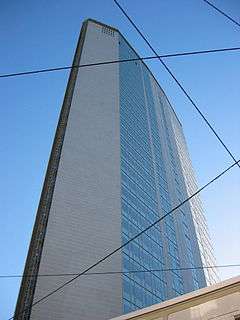Pirelli Tower
| Pirelli Tower | |
|---|---|
 | |
| Alternative names |
Pirellone Pirelli Tower |
| General information | |
| Status | Complete |
| Type | Commercial offices |
| Architectural style | Modernism |
| Location |
Via Fabio Filzi, 22 Milan, Italy |
| Coordinates | 45°29′05″N 9°12′05″E / 45.48472°N 9.20139°ECoordinates: 45°29′05″N 9°12′05″E / 45.48472°N 9.20139°E |
| Construction started | 1956 |
| Completed | 1958 |
| Owner | Regional Government of Lombardy |
| Height | |
| Antenna spire | 127 m (417 ft) |
| Roof | 124.1 m (407 ft) |
| Top floor | 112.8 m (370 ft) |
| Technical details | |
| Floor count |
32 2 below ground |
| Floor area | 24.000 m² |
| Lifts/elevators | 6 |
| Design and construction | |
| Architect |
Giò Ponti Pier Luigi Nervi |
| Main contractor | Pirelli & C. SpA |
| References | |
| [1][2][3][4] | |
Pirelli Tower (Italian: Grattacielo Pirelli - also called "Pirellone", literally "Big Pirelli"), is a 32-storey, 124.1 m (407 ft) skyscraper in Milan, Italy. The base of the building is 1,900 m2 (20,000 sq ft), with a length of 75.5 m (248 ft) and a width of 20.5 m (67 ft).[5] The construction used about 30,000 m3 (1,100,000 cu ft) of concrete. The building weighs about 70,000 t (69,000 long tons; 77,000 short tons) with a volume of 125,324 m3 (4,425,800 cu ft).
Characterized by a structural skeleton, curtain wall façades and tapered sides, it was among the first skyscrapers to abandon the customary block form. Until recently, it was the tallest building in Italy. The architectural historian Hasan-Uddin Khan praised it as 'one of the most elegant tall buildings in the world' and as one of the 'few tall European buildings [that made] statements that added to the vocabulary of the skyscraper'.
Pirelli building was the inspiration for the design of the Pan Am Building (now MetLife Building) in New York and Alpha Tower in Birmingham.
History
In 1950, Alberto Pirelli, the president of the Pirelli Company, ordered that a skyscraper be built in the area where the corporation's first factory was located in the 19th century. The project was developed by architect Gio Ponti, with the assistance of Pier Luigi Nervi and Arturo Danusso.
Construction of the tower began in 1956 when Italy was experiencing an economic boom. The tower was to be surrounded by low lying buildings on a pentagonal plot of land. Upon its completion in 1958, it became a symbol not only of Milan, but also of the national economic development. At 127 m (417 ft), it was the tallest building in Italy. The building was sold to the Lombardy regional administration in 1978. It has been the region headquarters until the completion of the new Palazzo Lombardia in 2010, where the offices have been moved.
Incidents
2002 plane crash
In the afternoon of 18 April 2002, a Rockwell Commander 112, an airplane with a single engine registered in Switzerland, hit the building. The aircraft was apparently scheduled to fly from Locarno to Milan. The plane was low on fuel and Linate Airport was preparing an emergency landing prior to the crash, but the pilot suddenly wandered off and flew right into the building. The pilot and two people inside the tower were killed in the accident. The purpose of the following project of general restoration was to conserve the integrity of the monument and at the same time to upgrade its status as executive headquarters, introducing new support services and technological systems.[6]
References
- ↑ Pirelli Tower at CTBUH Skyscraper Database
- ↑ Pirelli Tower at Emporis
- ↑ Pirelli Tower at SkyscraperPage
- ↑ Pirelli Tower at Structurae
- ↑ Il cielo in una stanza, informative brochure from Lombardy Region.
- ↑ See Alessandro Pergoli Campanelli, "Restoration of the facade of the Pirelli skyscraper in Milan in Frontiers of Architectural Research, 2014.
Further reading
- Terranova, Antonino; Valeria Manferto (2003). Skyscrapers. Vercelli: White Star Publishers. ISBN 8880952307.
External links
| ||||||||||||||||||
| ||||||